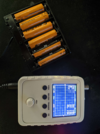Fluffyboii
Active Member
This got out of hand so I had to ask here. I am aware I am being to dependent on this forum and it is not something I enjoy. I tried solving this problem multiple times with different approaches and failed.
The problem is no matter how much gain I apply and how I filter the signal I can not get anything identifiable that looks like a hear beat on the oscilloscope. Even in the highest sensitivity which is something like 10mV, it is just flat noise with no ECG like component when I connect the props to my arms and leg. I started with AD620 datasheet circuit

And went to something as simple as this after nothing I did work.

When bottom circuit is tested with a signal generator I can see that It works and I have about 500 times gain. I put a low pass filter to output to set 3db point about 50Hz. Even if I amplify the output 100 times more to a total 5000 with 2 more op amp stages I get nothing. I tried 3 different breadboards, different ICs and checked the connections to props and confirmed that cables weren't open or broken in places. Even with the simplest circuit I should see some fluctuations in voltage with that much gain but instead I usually get 50Hz line noise or something that is about 5-10Hz that is not a heartbeat. Using the top circuit causes op amp to saturate and hit one of the rails even though "ground" is set to the body. Nothing I tried works. At this point I believe the connections are not working because we are not using the cream thing that is supposed to be used with securing the connection to skin.

I can not proceed with the project without getting any signal. Any ideas what may be holding me back.
The problem is no matter how much gain I apply and how I filter the signal I can not get anything identifiable that looks like a hear beat on the oscilloscope. Even in the highest sensitivity which is something like 10mV, it is just flat noise with no ECG like component when I connect the props to my arms and leg. I started with AD620 datasheet circuit
And went to something as simple as this after nothing I did work.
When bottom circuit is tested with a signal generator I can see that It works and I have about 500 times gain. I put a low pass filter to output to set 3db point about 50Hz. Even if I amplify the output 100 times more to a total 5000 with 2 more op amp stages I get nothing. I tried 3 different breadboards, different ICs and checked the connections to props and confirmed that cables weren't open or broken in places. Even with the simplest circuit I should see some fluctuations in voltage with that much gain but instead I usually get 50Hz line noise or something that is about 5-10Hz that is not a heartbeat. Using the top circuit causes op amp to saturate and hit one of the rails even though "ground" is set to the body. Nothing I tried works. At this point I believe the connections are not working because we are not using the cream thing that is supposed to be used with securing the connection to skin.
I can not proceed with the project without getting any signal. Any ideas what may be holding me back.

